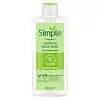What's inside
What's inside
 Key Ingredients
Key Ingredients

 Benefits
Benefits

 Concerns
Concerns

 Ingredients Side-by-side
Ingredients Side-by-side

Water
Skin ConditioningCocamidopropyl Betaine
CleansingDecyl Glucoside
CleansingGlycerin
HumectantDisodium Cocoyl Glutamate
CleansingTriethanolamine
BufferingSodium Ascorbyl Phosphate
AntioxidantCitric Acid
BufferingCitrullus Lanatus Fruit Extract
Skin ConditioningCucumis Sativus Fruit Extract
EmollientAloe Barbadensis Extract
Skin ConditioningMentha Piperita Oil
MaskingTocopheryl Acetate
AntioxidantPEG-40 Hydrogenated Castor Oil
EmulsifyingMenthol
MaskingAcrylates/C10-30 Alkyl Acrylate Crosspolymer
Emulsion StabilisingXanthan Gum
EmulsifyingPanthenol
Skin ConditioningBenzyl Alcohol
PerfumingEthylhexylglycerin
Skin ConditioningTocopherol
AntioxidantDisodium EDTA
CI 16185
Cosmetic ColorantWater, Cocamidopropyl Betaine, Decyl Glucoside, Glycerin, Disodium Cocoyl Glutamate, Triethanolamine, Sodium Ascorbyl Phosphate, Citric Acid, Citrullus Lanatus Fruit Extract, Cucumis Sativus Fruit Extract, Aloe Barbadensis Extract, Mentha Piperita Oil, Tocopheryl Acetate, PEG-40 Hydrogenated Castor Oil, Menthol, Acrylates/C10-30 Alkyl Acrylate Crosspolymer, Xanthan Gum, Panthenol, Benzyl Alcohol, Ethylhexylglycerin, Tocopherol, Disodium EDTA, CI 16185
 Reviews
Reviews

Ingredients Explained
These ingredients are found in both products.
Ingredients higher up in an ingredient list are typically present in a larger amount.
Decyl Glucoside is a glucose-based surfactant and emulsion stabilizer. It is created by reacting glucose with the fatty acids from plants.
Surfactants help clean the skin by trapping oil, sebum, and dirt to be washed away. As an emulsion stabilizer, it stabilizes the ingredients in a product by preventing them from separating.
This ingredient is biodegradable and non-toxic. This ingredient is commonly found in baby shampoos.
Decyl Glucoside is sometimes used to stabilize the UV filter Tinosorb.
Learn more about Decyl GlucosideDisodium EDTA plays a role in making products more stable by aiding other preservatives.
It is a chelating agent, meaning it neutralizes metal ions that may be found in a product.
Disodium EDTA is a salt of edetic acid and is found to be safe in cosmetic ingredients.
Learn more about Disodium EDTAPanthenol is a common ingredient that helps hydrate and soothe the skin. It is found naturally in our skin and hair.
There are two forms of panthenol: D and L.
D-panthenol is also known as dexpanthenol. Most cosmetics use dexpanthenol or a mixture of D and L-panthenol.
Panthenol is famous due to its ability to go deeper into the skin's layers. Using this ingredient has numerous pros (and no cons):
Like hyaluronic acid, panthenol is a humectant. Humectants are able to bind and hold large amounts of water to keep skin hydrated.
This ingredient works well for wound healing. It works by increasing tissue in the wound and helps close open wounds.
Once oxidized, panthenol converts to pantothenic acid. Panthothenic acid is found in all living cells.
This ingredient is also referred to as pro-vitamin B5.
Learn more about PanthenolWater. It's the most common cosmetic ingredient of all. You'll usually see it at the top of ingredient lists, meaning that it makes up the largest part of the product.
So why is it so popular? Water most often acts as a solvent - this means that it helps dissolve other ingredients into the formulation.
You'll also recognize water as that liquid we all need to stay alive. If you see this, drink a glass of water. Stay hydrated!
Learn more about Water